7: Limiting Reactant
- Page ID
- 316202
Learning Objectives
- To use observations to determine the correct reaction and stoichiometry.
- Determine the limiting reactant for different mixtures of the reactants.
- Use mole-mass relationships to calculate which reactant will be limiting.
Pre Lab Video
Separations
Solids are sometimes produced when a chemical reaction takes place. We call these solids a precipitate. There are several ways to separate a solid from a solution. Below you will find two different ways we will be using in lab.
Decanting
When decanting, the precipitate is given time to settle to the bottom of the container. Once the solid has settled, the liquid, or supernatant, is carefully poured out of a beaker leaving the solid behind.
Filtration
When a precipitate is present in a solution, we will use one of two types of filtration in our lab, gravity and suction filtration. During gravity filtration, filter paper is folded to fit into a long stem funnel by folding the filter paper in half and then in fourths (Figure 1 and 2). The filter paper is then opened such that one half has three thickness of filter paper and the other half has one (Figure 3). The filter paper is placed in the funnel and water is added to the filter paper to keep it in place (Figure 4). Note there should be a container placed under the funnel stem to catch the water and filtered solution, or filtrate. Decant as much of the solution as possible before pouring the solid in the funnel. This will increase the speed of filtration. Once the solid is transferred to the funnel, use a wash bottle to rinse the remaining solid from the original container to the funnel. Rinse several time to collect as much solid as possible (Figure 5).
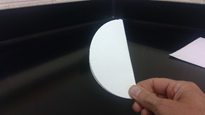 Figure \(\PageIndex{1}\): Folding the filter paper in half
Figure \(\PageIndex{1}\): Folding the filter paper in half
 Figure \(\PageIndex{2}\): Folding the filter paper in fourths
Figure \(\PageIndex{2}\): Folding the filter paper in fourths
 Figure \(\PageIndex{3}\): Opening the filter paper
Figure \(\PageIndex{3}\): Opening the filter paper
 Figure \(\PageIndex{4}\): Wetting the filter paper
Figure \(\PageIndex{4}\): Wetting the filter paper
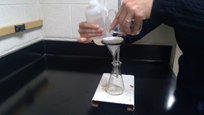 Figure \(\PageIndex{5}\): Final rinse of beaker.
Figure \(\PageIndex{5}\): Final rinse of beaker.
Safety and Waste Disposal
- The solutions must be disposed of in the hazardous waste container. Filter paper must be disposed of in the solid waste container.
Experiment:
This experiment has more experimental detail than previous experiments. However, you need to pay attention to what occurs in each step along the way. There are some questions embedded in the procedure that you need to answer before continuing on to the next step. These should be answered in your lab notebook, as they will help you with your discussion later. The questions are indicated in bold type. Be sure to answer all of them as you go.
Part I: What Happens when we mix cobalt (II) nitrate and sodium phosphate solutions together?
Answer all questions in your laboratory notebook as you complete this experiment.
Step 1
 Dissolve a small amount of cobalt (II) nitrate, Co(NO3)2, in about 20 mL of distilled water. Dissolve a similar
Dissolve a small amount of cobalt (II) nitrate, Co(NO3)2, in about 20 mL of distilled water. Dissolve a similar  amount of sodium phosphate, Na3PO4, in a second 20 mL of water. Describe the appearance of each solution.
amount of sodium phosphate, Na3PO4, in a second 20 mL of water. Describe the appearance of each solution.
Step 2
What ions are dissolved in each solution?
Step 3
Pour half of each solution into a third beaker and mix thoroughly. (Save the mixture and two solutions for later use.) Describe the appearance of the mixture.
Step 4
Assuming the reaction involves the coming together of dissolved ions, what are the possible identities of the solid formed in the mixture?
Step 5
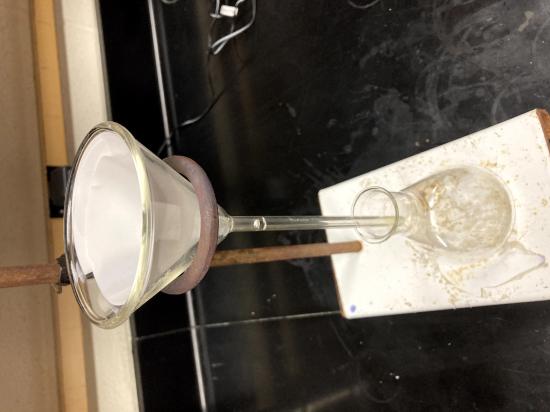 Separate the mixture by gravity filtration. Describe the characteristics of the liquid, called the filtrate. What are the possible identities of the ions in the solution?
Separate the mixture by gravity filtration. Describe the characteristics of the liquid, called the filtrate. What are the possible identities of the ions in the solution?
Step 6
Divide the filtrate in half and test each half with the remaining Co(NO3)2 and Na3PO4 solutions. Describe the results.
Step 7
Based on your results in part 6, identify the ions in the solution and the identity of the solid formed. Write a balanced chemical equation based on these results.
Step 8
Discuss your ideas with your lab instructor before continuing.
Part II: Can we tell which reactant runs out first?
Step 1
Record the concentrations of the Co(NO3)2 and Na3PO4 solutions in your notebook.
Step 2
Clean and rinse with distilled water four 100 mL beakers and label them 1-4.
Step 3
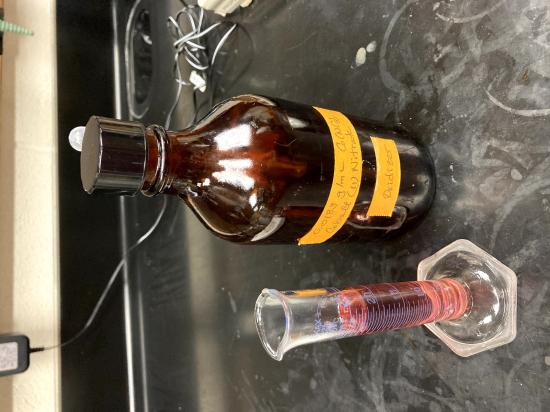 Into each beaker add 20.0 mL of stock Co(NO3)2 solution. Add different amounts of stock Na3PO4 into each
Into each beaker add 20.0 mL of stock Co(NO3)2 solution. Add different amounts of stock Na3PO4 into each 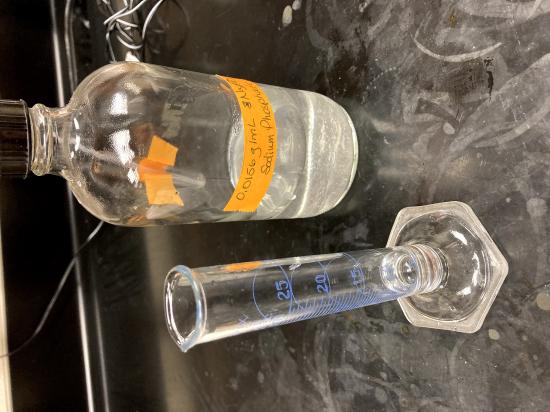 beaker. The suggested amounts are: 5.0, 10.0, 15.0, and 20.0 mL. Using the appropriate graduated cylinder, record exact the volumes of each solution you added in your table. Mix each solution thoroughly and allow it to stand for at least 5 minutes.
beaker. The suggested amounts are: 5.0, 10.0, 15.0, and 20.0 mL. Using the appropriate graduated cylinder, record exact the volumes of each solution you added in your table. Mix each solution thoroughly and allow it to stand for at least 5 minutes.
Step 4
While you are waiting, calculate the mass of Co(NO3)2 added to each beaker and record these amounts in the table in your notebook. Calculate the mass of Na3PO4 added to each beaker and record this in your notebook.
Step 5
Set up four filter funnels with filter papers and labeled collection beakers. Decant and filter each reaction mixture from part II through a separate funnel, collecting its filtrate in a labeled beaker. You are to collect 10-20 mL of each filtrate, clean of any precipitate. If the filtrate is cloudy, refilter your solution.
Step 6
Describe the appearance of each of your filtrates.
Step 7
Divide each of the filtrate into two parts. Test one part with a dropperful of stock Co(NO3)2 solution and the other with a dropper full of stock Na3PO4 solution. Summarize the results of these tests in your notebook.

